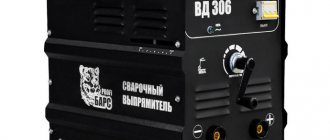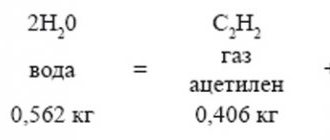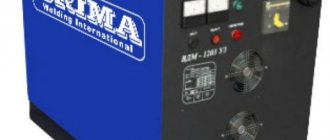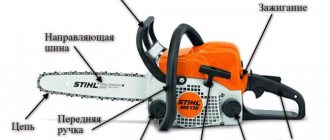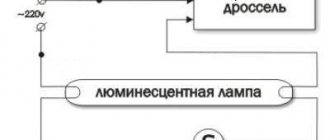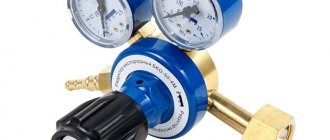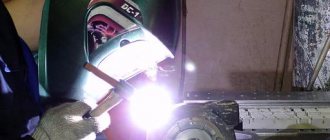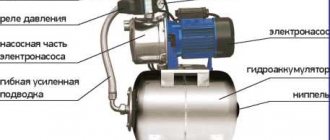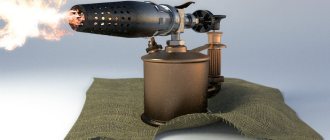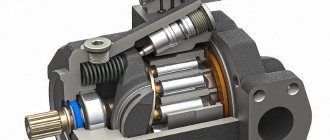Characteristics
The semi-automatic torch included in the kit is, in fact, a functional product with a complex design, designed to produce high-quality seam joints under gas protection.
Such equipment belongs to the consumable class, since many parts in the design have a short service life - with careful operation, the average service life does not exceed 6 months. The main differences are that the product has an individual cooling system, as well as a channel for feeding filler wire . With the help of such a torch, the performer can weld metals in hard-to-reach places. Torch tips are made from metals or materials such as copper, tungsten or bronze, an alloy of copper and graphite.
How to use
So, a welding torch has been selected and purchased. What's next? And then you need to use it. And use it correctly. Yes, there are a few key rules here too. Follow them to achieve decent quality seams. We will tell you about the sequence of work.
Prepare the metal before using the torch. It must be thoroughly cleaned of dirt and corrosion. Secure the parts so that your hands are free while working. parts can be fixed using clamps.
Unscrew the valve on the gas cylinder and wait a few seconds. Then find the nozzle for the semi-automatic welding machine on the torch and bring an open flame to it. At the same time, open the gas supply from the cylinder. But in no case is it the other way around. To open the gas supply, press the handle, it is located on the burner. After these manipulations and the burner, a flame should appear. But it can't be used yet. Needs to be adjusted. Here everything is done by eye. The flame should not be too strong or too weak. Make sure the flame burns evenly. Correct tuning will come with experience. Don't be discouraged if you can't adjust the flame the way you need it the first time.
Heat the joints using a torch. Heat evenly without making unnecessary movements. At this stage, experience is also important, since you can determine by eye the speed of movement of the torch relative to the joint. Keep track of the color of the metal and remember the result you get. This way you can analyze your mistakes in the future.
Weld the metal according to your chosen technology. After welding, you do not need to immediately turn off the gas supply. Wait a few seconds and press the lever on the burner to stop the gas supply. This is necessary to ensure that the welding zone is not oxidized by oxygen. Screw the valve back on the cylinder.
Principle of operation
It consists of the following points:
- The product is brought to the part at a distance sufficient to excite the welding arc.
- Seconds before ignition, protective gas is supplied.
- Electric current is supplied to a special tip and the workpiece.
- The temperature of the arc melts the wire and, under a cloud of shielding gas, enters the weld pool.
- The performer moves the torch with smooth movements, forming a welding seam.
- The gas prevents air molecules from oxidizing the seam joint.
- During operation, product parts are exposed to high temperatures.
As we can see from the last point, the nozzle, electrode holder or gas divider and conductive tip are subject to severe wear .
Order welding equipment in
High-quality, reliable welding torches with excellent technical performance are presented in the TECHRESURS online store. From a huge assortment, choose the best model of welding equipment, as well as a set of consumables to ensure normal operation of the unit.
We cooperate directly with manufacturers, the prices of goods are very reasonable. We provide expert advice on the selection of burners and components. You can place an order through the shopping cart on the website or by phone. Payment is possible in cash, bank transfer, card. We organize delivery throughout St. Petersburg and the Leningrad region.
Design nuances
A torch for semi-automatic welding is supplied complete with the unit and is used to supply solder and a protective cloud of gas into the weld pool.
The equipment is as follows: a hollow handle, an insulating sleeve and washer, a wire holder, a conductive tip, a nozzle with a divider. The tip and nozzle, which are consumable parts, are subject to heavy loads and must be replaced frequently due to exposure to high temperatures.
What is a semi-automatic machine
A person who wants to master welding techniques must first understand what a semi-automatic welding machine is and study its structure. In simple terms, it is an electromechanical device in which a welding wire acts as a consumable electrode and is fed into the welding zone.
The operating unit kit consists of several components:
- main unit, consisting of a transformer for supplying power and a mechanism for feeding wire;
- hose or welding sleeve for semi-automatic machine
- semi-automatic welding torch, inside which the wire is placed
- conductive tip for semi-automatic machines - it is usually called a nozzle for semi-automatic machines
- inert gas supply system
Main product parameters
The MIG/MAG welding torch for semi-automatic equipment is produced by different manufacturers, but all the main characteristics are almost identical:
- applied current load;
- hose length;
- cooling option - using air or water;
- control - using buttons, valves or a universal option;
- Connection method: plug-in or European type.
The use of a plug increases the diameter of the sleeve, because each source is connected separately. Euro connectors are used only on expensive professional equipment, when all channels are combined in one housing. Experienced welders select torches based on the current value , since work is not carried out in a constant mode, but with stops to cool down expensive equipment.
When developing burners, manufacturers calculate the durability of the product based on stable operation for 10 minutes, but in practice this is not done. If the unit indicates a maximum current of 400A, then the ideal use case would be a burner rated at 300A.
Care and operation
If you expect long-term operation of the welding torch, you must provide it with proper care and maintenance and follow the operating rules. During operation, the burner and its components become dirty and clogged, which negatively affects their performance. The wire feeder needs to be cleaned regularly. For this purpose, compressed air is usually used. It removes metal dust. Regular dust also accumulates on the internal surfaces of working units. This leads to burnout of power transistors and affects the insulation resistance.
If the torch is not working properly, the quality of the weld will deteriorate. Minor breakdowns lead to more significant ones. One of the most common problems is nozzle burning. Under normal conditions, this element is protected from the circuit, so it should not burn. This happens due to metal splashes on the working parts. To extend the life of the nozzle, you should regularly clean the equipment using special metal splash cleaners.
Inverter components
The inverter burner is not much different from other similar products, providing a direct current connection of any polarity. When choosing, you need to pay attention to the duration of continuous operation at currents of straight polarity . For example, the SRT-26V brand torch is designed for argon arc welding and is suitable for joining different types of steel.
It is used for welding pipelines and when it is necessary to obtain a beautiful appearance of the seam joint. In this case, the burner is connected to the minus on the inverter, and the supply hose is connected to the gas cylinder reducer. The supply of shielding gas is regulated by a valve on the product holder.
Yu. N. Tolstykh, education: college, welder training, specialty: fifth-class welder, work experience: since 2002: “Operations with such torches when welding ferrous metals must be carried out in direct current mode and with direct connection, the exception is work with non-ferrous metals, such as aluminum or magnesium.”
Features of wire welding
Features of welding with wire using semi-automatic equipment are as follows:
- the filler material must correspond to the chemical composition of the product being welded;
- the wire must meet government standards and be made from the correct components;
- The terms and conditions for storing filler wire must be strictly observed.
A review of the features of work using filler wire should begin with welding basics. Most metals welded in production or at home are steel and manganese. Wire for connecting such products is the most in demand.
Welding of ferrous metals is usually carried out using the following types of filler material:
- Wire Sv-08GS for joining low-carbon and alloy steels.
- Wire Sv-08G2s for welding high-carbon steel.
Flux-cored wire is often used for welding ferrous metal products. This filler material allows welding to be carried out without additional gas supply to the welding zone.
Self-fluxing wire is a low-carbon steel tube with a powder core. When the metal melts, powder is released, forming a gaseous environment to protect the weld. As a rule, the fluxing powder contains rutile and metal dust.
The connection of aluminum parts is carried out using SV-AK5 wire. A characteristic feature of this filler material is the unique color of the weld. Immediately before joining aluminum products, preparation should be carried out.
Semi-automatic welding using flux-cored wire.
This procedure is divided into steps:
- Creating bevels or chamfers.
- Mechanical cleaning of surfaces.
- Washing with caustic substances to slow down the formation of a refractory oxide film on the surface of an aluminum product.
- Preparation of a Teflon channel to reduce friction of the filler wire on the walls of a semi-automatic welding device.
Step-by-step instructions for using carbon dioxide welding for beginners include the following subparagraphs:
- removing all foreign objects from the workplace;
- turning on maximum lighting;
- preparation of material and tools;
- checking cable connections and functionality of extension cords.
After completing the above points, you should proceed to preparing the electric arc welding machine.
To do this you need:
- unwind the welding sleeve;
- connect the gas cylinder;
- check the burner nozzle;
- conveniently place all the parts to be connected and fasten them securely;
- dress in welder's work clothes;
- connect semi-automatic equipment to the network;
- bring the torch to the intended connection site.
Upon completion of welding work using wire, you should:
- remove your fingers from the wire feed buttons;
- shut off the gas supply;
- turn off the power to the equipment;
- Allow the seam to cool for several minutes;
- If defects are found, repeat welding.
The semi-automatic welding machine allows you to use all types of filler wire.
When performing work, it is important not to forget about protective equipment. Semiautomatic welding machine with thyristor control
Semiautomatic welding machine with thyristor control.
The most complete welder equipment consists of:
- Eye protection. The ideal equipment to protect a welder's vision is a mask, face shields and goggles.
- Respiratory protection. Special filter masks will help the master to significantly reduce the impact of harmful fumes on internal organs.
- Splash protection. Full body protection should include a flame retardant jacket and trousers. You can use overalls.
Safety precautions when performing welding work include the following rules:
- Carrying out work from wooden scaffolding. The use of metal protective masks and helmets is prohibited.
- Providing light flux from a 12 volt power source.
- Providing insurance for the welder using a string attached to the belt. The rope size must be at least 2 meters.
- Providing the workplace with a special hood that ensures the removal of harmful fumes from the work area. In cases where it is impossible to provide exhaust, the welder must work in a hose gas mask or respirator.
- Do not touch the workpiece to be welded with bare hands.
- It is prohibited to carry out work in open areas during precipitation.
Treatment in domestic conditions
Today, gas welding is no longer considered a complex option for joining metals and is practiced in the private sector by many users. It must be remembered that when organizing this type of work at home, special safety requirements must be strictly followed .
First of all, the tightness of the working gas supply channels is checked, then the burner is visually inspected - special attention is paid to the condition of the tip.
Carefully check the joints with the connecting nipples to ensure that there is no gas leakage, which can cause a fire.
Gas cylinders cannot be carried by hand, but should be transported on a special trolley with a soft ride (on inflatable wheels); the containers should be stored in an iron box equipped with a reliable lock to prevent access by strangers, especially curious young children. Do not work with similar equipment near flammable and combustible substances.
Recommendations for choosing a burner
On sale you can find simply a huge number of different versions of gas burners. There are also quite a lot of manufacturers; most attention is paid to the products of the Rems and Rothenberger brands. The price range is quite wide, it all depends on the features of a particular model.
Some models of torches are designed not only for soldering, but also for cutting metal and defrosting, as well as treating surfaces at high temperatures. The device is selected according to the following criteria:
What kind of material requires processing. Each metal has a specific melting point. Some alloys, such as copper or aluminum, should be heated to a lower temperature. Other alloys are much more difficult to process. Some burner devices can heat the surface to high temperatures and can be used for a long period. It should be remembered that a gas torch designed for melting metal and subsequent soldering will not perform well when cutting. That is why the choice is made according to purpose. A wide variety of gases are used as fuel. Let's use propane or acetylene as an example. It is worth considering that some models can be used with other gases. It is recommended to use a tool that runs on one type of fuel. The propane torch used in industry has become widespread. There are two types of design: injection and non-injection. This structural element is designed to mix fuel with oxygen. The power of the device can vary over a fairly wide range. It should be taken into account that as the power indicator increases, the efficiency of the device also increases. Powerful gas burners are used to work with thick-walled pipes that are difficult to process. You should decide how often the work will be carried out
If soldering will be carried out frequently, then it is best to pay attention to a model from a well-known manufacturer with high reliability.
When soldering copper pipes, certain safety precautions must be observed. This requires:
- Protective gloves. The surface can heat up to a very high temperature and you can get burned if you touch it. In order to eliminate the possibility of burns on your hands, you should use gloves with thick fabric.
- It is recommended to carry out work exclusively in a ventilated area with good ventilation. This is due to the fact that gases and other combustion products may appear. In addition, do not forget that the gas used is explosive. That is why the appearance of even a small leak can lead to an increase in gas concentration.
- Before checking the quality of the connection, make sure that it has cooled down. This is due to the fact that the surface can heat up to a fairly high temperature.
In conclusion, we note that gas burners should be used in compliance with safety precautions. Homemade designs must be tested before use. As for purchasing ready-made burners, you should immediately decide on your budget.
If you find an error, please select a piece of text and press Ctrl+Enter.
Security basics
We present a list of requirements when working with semi-automatic equipment:
- The contractor is obliged to check the serviceability of the starting system before starting work.
- The power source and the device box must have reliable grounding.
- The switch or magnetic starter is turned on first, and then the hardware box. Turning off the power is done in reverse order.
- All supply hose connections must be sealed.
- Leaning, let alone sitting down, or placing foreign objects on the equipment is prohibited.
- Winding a wire onto a spool is done independently only after undergoing special training with mandatory recording in the instruction book.
- After completing the work, first turn off the gas and water supply for cooling, then you need to turn off the power to the equipment.
- Report any noticed equipment malfunctions to the foreman or foreman and do not turn on the equipment without instructions from management.
- The contractor is prohibited from eliminating any malfunctions on his own.
A team of repairmen is engaged in servicing various equipment in the workshop - only they can repair and configure the equipment.
Maintenance
All torches for semi-automatic welding machines require regular visual inspection and preventive maintenance to identify deficiencies, for example, the nozzle is exposed to splashes of molten metal, which must be removed constantly after welding. This is done mechanically, as a result of which microcracks remain; the service life of the part is no more than 6 months .
All contact elements operate in short-circuit protection mode, so sometimes they partially burn out, and this leads to a decrease in the main characteristics, so periodic cleaning is required, and if they burn out, a complete replacement is required. The intended service life is no more than 200 hours of continuous operation, so spare contacts are included with the new product.
Non-stick spray for welding without silicone
Non-stick spray from M-WELD is an oily substance that is a mixture of synthetic agents with denatured hydrocarbons. It can be used in two ways:
- it is used to process the torch nozzle of the welding machine before starting work;
- Before welding, the surfaces of the parts to be welded are coated with the composition.
Non-stick spray forms a protective film with an average thickness of 2-3 microns, which allows you to work effectively for 3-4 hours. At the same time, both the burner itself and the surfaces of the parts being welded are reliably protected from the damaging effects of molten metal and high temperatures. And, as a consequence of this, the service life of the burner as a whole and all its replaceable parts increases. With the use of a spray, welding work becomes less labor-intensive, since there is no need to clean the area around the weld.
There is no silicone in the spray formulation, so the finished product can be varnished, chrome-plated, or galvanized. The composition of M-WELD non-stick spray is odorless, soluble in water, does not irritate the skin and upper respiratory tract, and is therefore safe for humans.
Saving Tips
A burner for semi-automatic operation is selected depending on the volume and complexity of future work . The handle is comfortable to hold with one hand and is lightweight. In this case, you need to remember the following nuances:
- It is necessary to select products with lower welding current values than those indicated on the equipment, since manufacturers indicate a maximum temperature above which the handle or sleeve fails, but the product itself retains all functionality.
- Operation is designed for 100% load, but in practice such a mode does not exist.
As mentioned above, for normal use a product with a current of 300 amperes is sufficient , because you pay less, but create optimal conditions for normal operation of the burner.
Semi-automatic welding rules
First of all, when starting to work with a semi-automatic machine, the parts intended for connection must be well cleaned of paint and rust. You should also clean the area where the mass clamp will be attached.
How to hold the burner
You can hold the torch with one hand, but the quality of the seam will be better if you use both. One hand serves as a support, and the other holds the burner.
With this method, it is easier to control the angle and distance of the torch from the workpiece, as well as carry out the necessary movements to form a high-quality seam. To keep your hands free, you need to use a welding mask that is attached to your head.
There is no ideal angle when working with a semi-automatic machine. Typically, to connect workpieces lying in the same plane, a torch tilt (from the vertical position) of 15-20 degrees is used. When connecting parts that are at an angle to each other, a burner tilt of 45° is used. Each welder, with experience, selects the most convenient angle of inclination of the tool, taking into account various situations.
Torch movements
To form a high-quality seam, there are many ways to move the torch.
- For metals with a thickness of 1-2 mm, a wavy-zigzag movement is used. Thus, the arc captures both sheets of metal and does not have time to burn through it. As a result, the seam is tight and durable.
- For welding metals of any thickness, a straight seam is used, eliminating any sideways movements. But in this case, the operator is required to have some experience so that when moving the torch, the arc evenly affects both mating parts.
- If you are going to work on metal with a thickness of less than 1 mm, then you should reduce the current strength and wire feed speed, and also use wire of a smaller diameter. Welding should occur in short pulses, with a pause between them of about 1 second. A pause is needed to cool the metal and merge the next segments into a monolithic seam.
- If long, thin parts are mated, then welding is carried out in short segments or points located at a certain distance. Also, to avoid deformation of parts, you can cook alternately, in short segments, from different ends of the mating segment.

